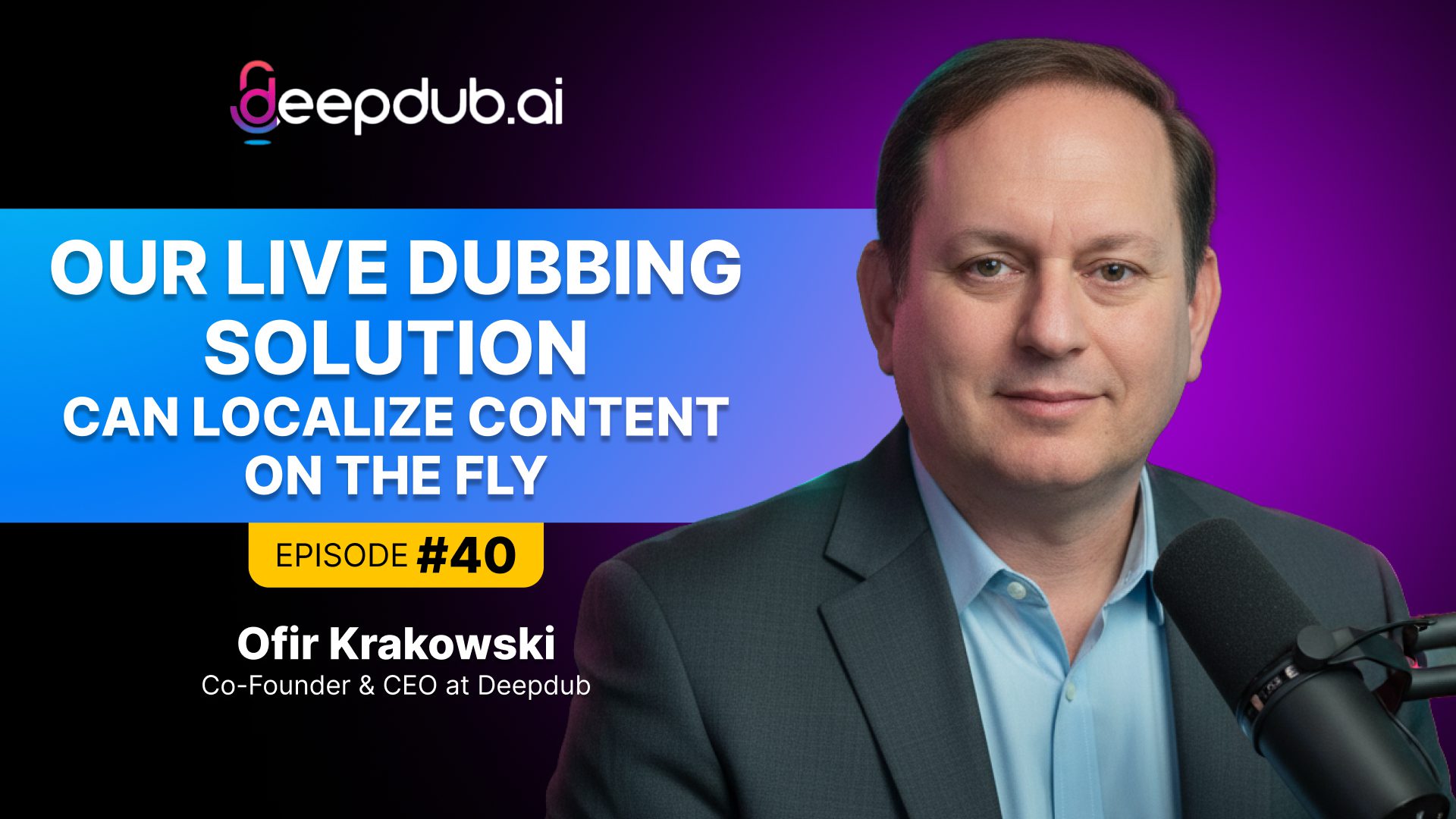It’s not only about building great technology—it’s about how you manifest emotion through voice. That’s why we created ETTS: Emotional Text-to-Speech.
Podcast Chapters
| Timestamp | Chapter Title |
| 00:00 | Introduction to DeepDub AI and Ofir Krakowski |
| 02:51 | Ofir’s Background and the Genesis of DeepDub |
| 06:02 | The Need for Localization in Global Content |
| 08:47 | DeepDub’s Solutions and Innovations |
| 11:56 | The Live Dubbing Solution and Its Impact |
| 18:05 | Clientele and Market Dynamics |
| 35:58 | Operationalizing Content Localization |
| 52:02 | Expanding into the Asia-Pacific Market |
Our live dubbing solution can localize content on the fly with just 15 seconds of latency—and going down to 10. Whether it’s a football match or a news broadcast, it can now be delivered in real time, in any language. That’s not just innovation—it’s inclusion at scale.
Key Takeaways:
1. 🌐 AI Localization at Scale
DeepDub enables frictionless, multi-language content delivery—crucial for global expansion strategies.
2. 🧠 Emotionally Intelligent Voices
Their ETTS model captures tone, context, and cultural nuance—not just text-to-speech.
3. ⚡ Live Dubbing Infrastructure
Sub-10s latency opens up real-time localization for live broadcasts, sports, and events.
4. 🧰 Modular, Integrated Stack
A full pipeline—from transcription to voice synthesis—designed for studio-grade automation.
5. 📈 Strategic Library Monetization
AI makes it viable to localize and monetize vast, previously untapped content libraries.
Sound Bites:
🎙️ “Voice is the new operating system of the world.”
🎙️ “Localization isn’t just translation—it’s emotional connection.”
🎙️ “Live dubbing at 10 seconds latency is a game changer.”
🎙️ “AI lets one person produce a 100-character dub—at studio quality.”
🎙️ “We’re not cloning voices—we’re creating new ones, ethically and at scale.”
About Deepdub
Why Partner With Deepdub?
-
🌐 Reach Global Audiences Instantly
Leverage DeepDub’s AI to localize content into 130+ languages—quickly and affordably. -
⚡ Live Dubbing, Real-Time Impact
Offer live sports, news, and events in multiple languages with <15s latency dubbing—no delays, just engagement. -
🔗 Seamless Workflow Integration
From API access to DeepDubGo, easily plug into your systems for end-to-end localization automation. -
🗣️ Ethically Sourced, Revenue-Sharing Voices
Use real licensed voices with full traceability—plus a royalty model for voice contributors. -
💰 Monetize Your Content Library
Unlock revenue from old or unused content by localizing at scale and testing new markets fast.
In Conversation with Ofir Krakowski, CEO of DeepDub
This is the written version of the above podcast, summarised for quick reading. The interview is republished in a Q&A format for clarity and depth. Here are key highlights from Ofir Krakowski’s conversation with the Vitrina team, focused on the evolution of AI-driven localization and the future of global content access.
1. Vitrina: Ofir, take us through your background and what led you to build DeepDub?
Ofir Krakowski:
“I started as a geek child using technology… building on early Apple computers. I have over 30 years of experience in computer science, including my time building the AI department in the Israeli Air Force. This is my second AI company. When we founded DeepDub in 2019, voice models weren’t on anyone’s radar—most research focused on voice recognition, not generation.
But I saw a gap: 60% of internet content was in English, yet 90% of the world doesn’t speak English. Traditional localization methods were too expensive and slow. At the same time, I saw my own kids sending voice messages on WhatsApp—voice was becoming the new interface. We realized voice models would become the next operating system of the world. That was the insight that launched DeepDub.”
2. Vitrina: What exactly does DeepDub do, and how do you define your product suite?
Ofir Krakowski:
“At its core, DeepDub builds solutions to eliminate language barriers. We do this through a full-stack AI-driven localization workflow: transcription, translation, voice generation, lip sync, and mixing. We’ve built each part ourselves, which allows us to offer flexibility via APIs or our self-service platform, DeepDubGo.
Our proprietary ETTS model—Emotional Text-To-Speech—sets us apart. It doesn’t just synthesize voice, it captures emotion and context. We even introduced a unique AI-aided translation tool where translators can ask the AI questions like: ‘What is the context of this sentence?’ or ‘What does this word mean in this setting?’ That improves quality dramatically.
A great example: if you’re translating a drama versus a reality show, tone and style matter. Our system can adapt accordingly.”
3. Vitrina: Tell us more about your live dubbing solution. How does it work, and what are the use cases?
Ofir Krakowski:
“We launched our live dubbing product just three weeks ago. It can localize content on the fly with just 15 seconds of latency, soon going down to 10. This is huge for sports, news, and other live formats.
Imagine you’re broadcasting a football match, and it’s instantly dubbed into Telugu, Spanish, or French. No pre-processing, no manual uploads. Just stream and localize. And this isn’t limited to media. Even our podcast here could be simultaneously dubbed into 20 languages for global audiences.”
4. Vitrina: What types of customers do you typically work with, and how do they engage with DeepDub?
Ofir Krakowski:
“Our clients range from studios to distributors, broadcasters, and streamers. Many of them have massive archives that haven’t been monetized because localization was too expensive.
For example, one distributor used DeepDub to test a new market. They took a few shows, localized them with us using AI dubbing, and released them. Once they saw strong engagement, they expanded to larger portions of their library. This method allows them to test territories quickly without major upfront costs.
We also support different workflows—some plug into our API for automated delivery, while others use our DeepDubGo platform for manual uploads. It’s very flexible.”
5. Vitrina: How do you approach voice casting? Can clients clone actor voices?
Ofir Krakowski:
“Most library content doesn’t have the rights to reuse actors’ voices. We respect that and don’t do unauthorized cloning. Instead, we’ve built a vast catalog of licensed voices, sourced ethically—including from everyday people who are compensated.
We add layers like accent control. So, for instance, a Spanish-speaking voice can be adapted to deliver Japanese dialogue with the same tone and color. That’s not cloning—it’s synthesizing a new performance.
Clients can also select regional variations—British English, Australian English, etc. Plus, we offer a royalty program where voice actors can upload samples and earn when their voice is used—even in other languages.”
6. Vitrina: Can you give examples of how DeepDub is used upstream in production workflows?
Ofir Krakowski:
“Studios use us for ADR—Automated Dialogue Replacement. Instead of calling an actor back months after shooting, they recreate or fix a line with our system. It’s fast and seamless.
Another use case is trailer creation. Many films lack localized trailers because it’s expensive. With us, studios can generate trailers in multiple languages without bringing in talent.
We’ve also worked on anonymized reality shows—replacing real voices with synthetic ones for privacy, without using robotic filters. And in animation or sci-fi, we’ve created voices for creatures or machines—custom designed by combining characteristics from different speakers. One show even asked us to build a hybrid voice using the modulation of one actor and the tone of another.”
7. Vitrina: What are your language capabilities? Do you support non-English source content?
Ofir Krakowski:
“We support 130 languages, and we’re completely source-agnostic. You can go from any language to any other.
The challenge lies in translation quality. Some languages like Tamil or Hebrew aren’t well-supported by major models. So we use multiple engines, and for critical content, we recommend human QA.
Since we own the full stack, we can integrate new engines as they evolve—our clients benefit automatically. And we even allow glossaries for domain-specific topics like sports, finance, or medicine.”
8. Vitrina: What’s next for DeepDub? Which markets are you excited to expand into?
Ofir Krakowski:
“We’re eyeing the Asia-Pacific region—especially India, Japan, Indonesia, Thailand. These are massively underserved when it comes to both importing and exporting content.
India, for example, has 20+ official languages. Much of its own content is stuck within language borders. Imagine the global impact if Indian educational, entertainment, and cultural content were instantly available in French, Spanish, or Arabic. And vice versa—Korean or Japanese content reaching regional Indian audiences instantly. That’s where DeepDub comes in.
We also see FAST channels as a major opportunity. We’re already working with platforms like SoFast, which distribute to 160+ regions. Fast, ad-supported content needs low-cost, scalable localization—our live dubbing makes that possible.”





 Tel Aviv-Yafo, Israel
Tel Aviv-Yafo, Israel




